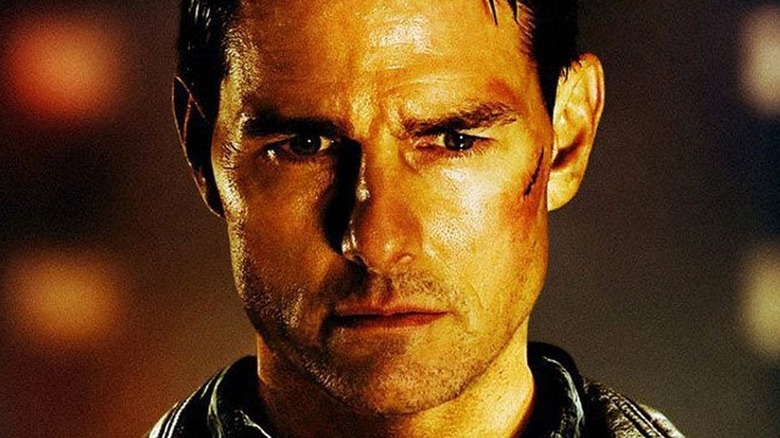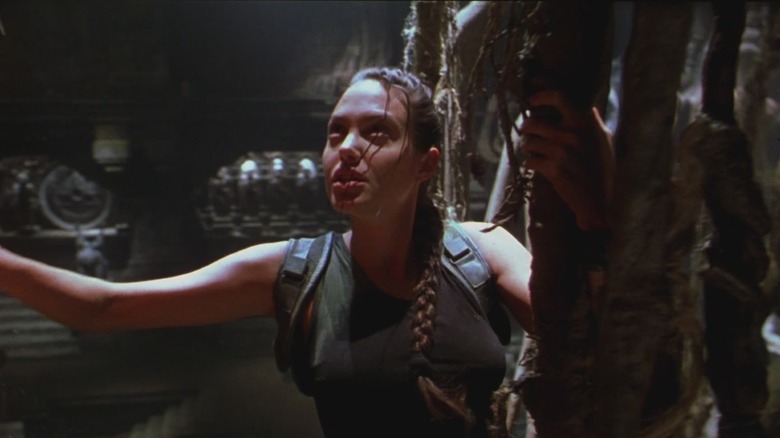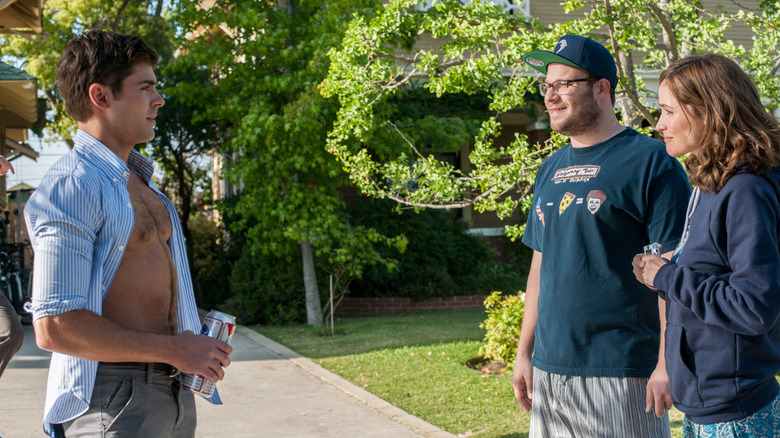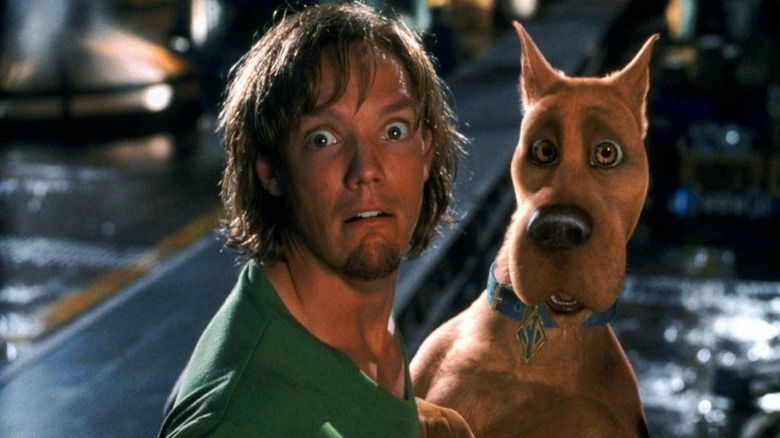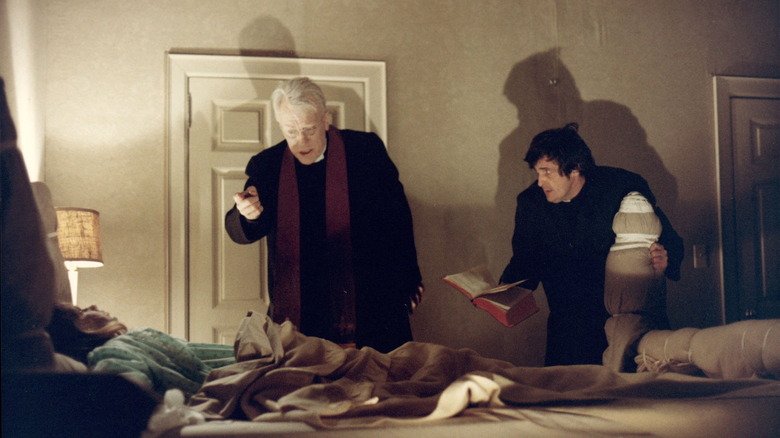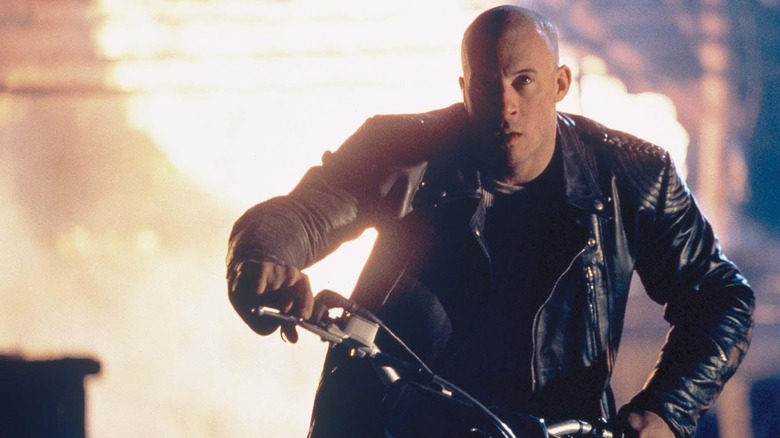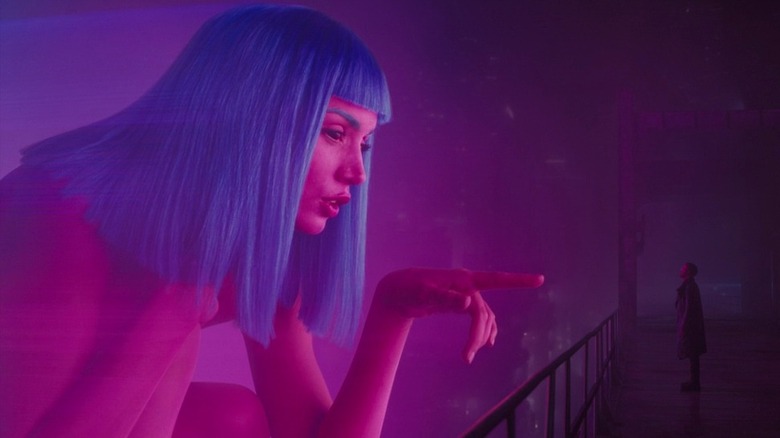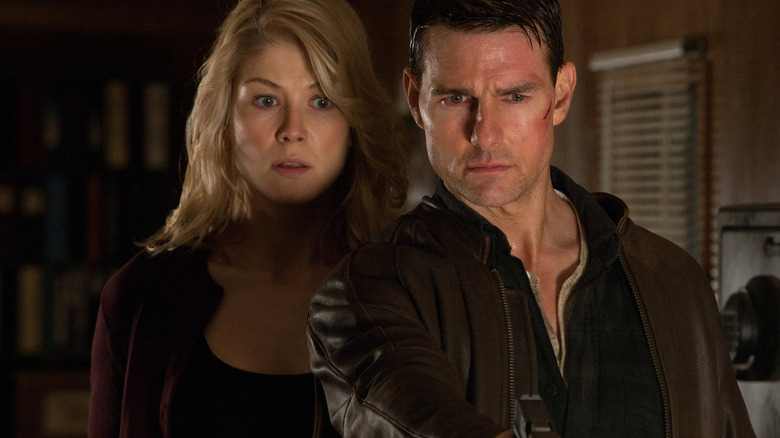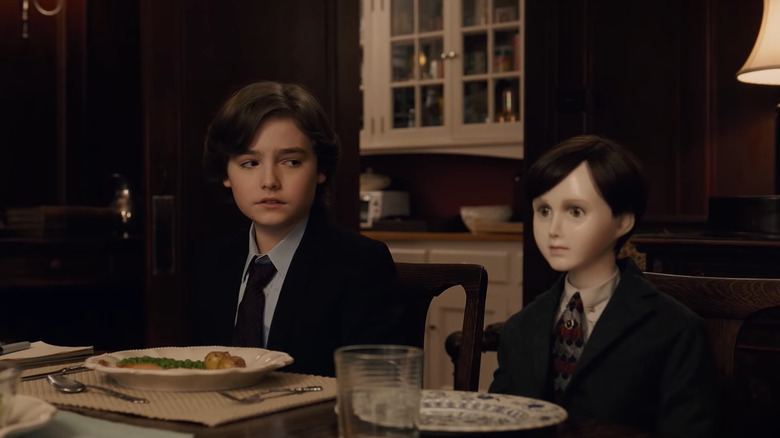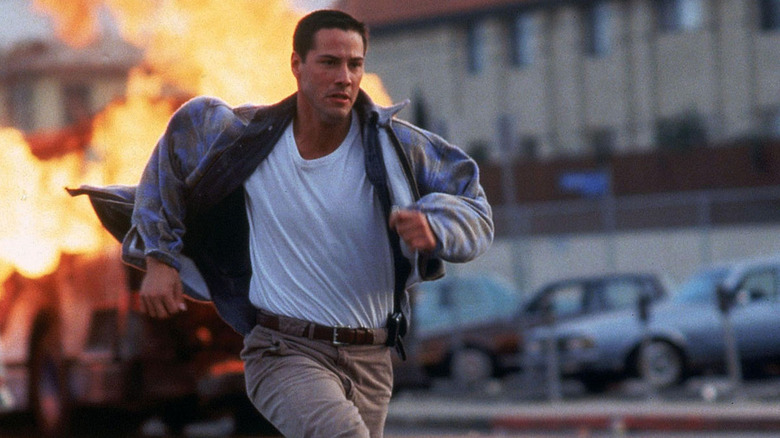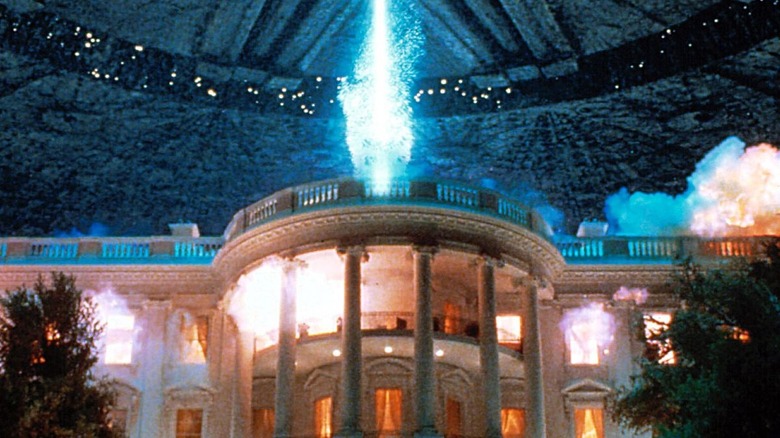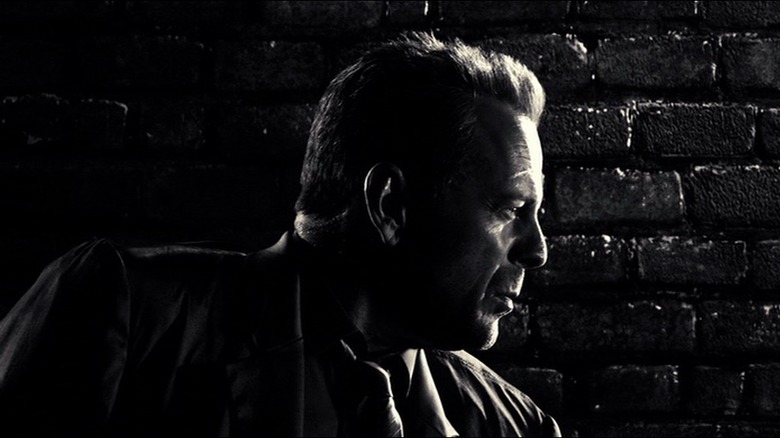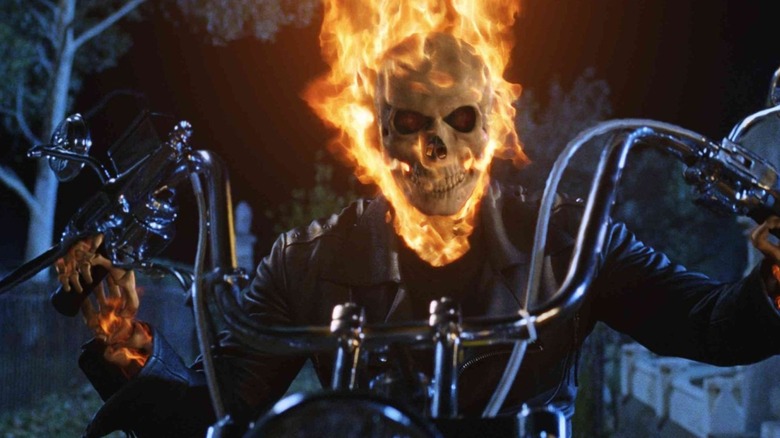Movie Series That Failed As Soon As The First Sequel Came Out
The biggest film franchises don't just span multiple installments, but multiple decades. The likes of the James Bond movies or the "Star Wars" saga have been entertaining several generations of audiences with no end in sight. These films show just how enduring these sorts of blockbusters are if they manage to resonate with people and keep providing satisfying further adventures. But not every movie series gets to that point. Managing to spawn your first sequel is only the first step in the journey to becoming the next "Star Wars," and too many features drop the ball at that point.
These are the motion pictures that did prove successful enough to warrant a sequel, but whose follow-ups managed to land so far beneath expectations that the whole reputation of the franchise tanked. The circumstances that informed these franchises' first sequels crashing so badly vary greatly from one movie to the next. Some struggled to get the attention of moviegoers thanks to bad marketing, while others just never had enough audience devotion to warrant a sequel in the first place. Whatever the case, these sequels derailed their respective franchises. While a handful of these sagas did manage to produce follow-ups (albeit obscure and troubled ones) in the wake of these disastrous installments, things were never the same for any of these movie series after these first sequels.
The original Lara Croft movies
Lara Croft as a video game character has regularly headlined new solo adventures, which has turned this fictional figure into one of the more enduring characters of 1990s video games. On the big screen, though, Lara Croft hasn't been so lucky, with the original live-action movie adaptation of the character (played by Angelina Jolie) sputtering out after just two entries. It didn't initially seem like the franchise would be so short-lived, since her first movie, "Lara Croft: Tomb Raider," made so much bank at the worldwide box office in the summer of 2001. The film was so lucrative that it still stands as one of Jolie's highest-grossing star vehicles globally.
Capitalizing on the popularity of Croft and the rising profile of Jolie, "Lara Croft: Tomb Raider" came along at the perfect time in every respect. Unfortunately, it wasn't that beloved by audiences and, despite there being countless video games starring this character, there just wasn't much demand for a sequel. When "Lara Croft: The Cradle of Life" dropped into multiplexes in the summer of 2003, moviegoers gave the production the cold shoulder. With the film making 43% less than its predecessor, it was game over for the "Lara Croft" movie franchise. Thanks to this extremely disappointing box office development, this staple of video games wouldn't come back to movie theaters for 15 years, in a reboot simply entitled "Tomb Raider."
Neighbors
Box office expectations often miss severely when it comes to comedy sequels. While projects like "City Slickers" or "Horrible Bosses" made big bucks at the worldwide box office, their respective follow-ups just failed to click with moviegoers. Still, the allure of delivering the rare "The Hangover: Part II" or "22 Jump Street" at the worldwide box office means that studios still try their luck at launching hit comedy franchises. This includes a follow-up to the 2014 sleeper hit "Neighbors," which ended up becoming one of Seth Rogen's biggest movies.
The same could not be said for "Neighbors 2: Sorority Rising," a follow-up that flipped the script and had a sorority rather than a fraternity move in next to Rogen and Rose Byrne's house. The result was a project that just didn't connect with moviegoers, partially because the premise didn't offer enough that was different from the original. Though technically profitable after making $108.7 million worldwide on a $35 million budget, that was a massive step down from the first "Neighbors." Any potential for "Neighbors" becoming like "The Hangover" and going on for an entire trilogy was stopped cold with "Sorority Rising," which turned out to be both a franchise killer and another example of an underperforming comedy sequel.
Scooby-Doo
In 2002, "Scooby-Doo" proved to be a box office hit, and how could it not? A live-action film adaptation of one of the most popular kids cartoons in history, "Scooby-Doo" offered something that could appeal to youngsters and nostalgic adults alike. However, live-action adaptations of cartoons tend to be projects that only work financially once. The novelty has worn off for audiences after a single installment and there isn't much need for follow-ups. "The Smurfs 2," "Garfield: A Tale of Two Kitties," "Peter Rabbit 2" ... the list of examples go on and on.
"Scooby-Doo" also suffered from this phenomenon, as the sequel, "Scooby-Doo 2: Monsters Unleashed," disappointed at the box office. The film's $181 million worldwide gross was roughly 35% off from the global box office haul of its predecessor. "Monsters Unleashed" may have delivered more familiar "Scooby-Doo" foes from the original cartoon, but this new installment suffered from the mixed reception to the original "Scooby-Doo" as well as a less hospitable March release date compared to the first film's June launchpad. With these financial shortcomings, another theatrical live-action "Scooby-Doo," penned by James Gunn and meant to take place in Scotland, was shelved and this particular incarnation of the sleuthing canine was put on ice.
The Exorcist
The original "The Exorcist" wasn't just a hit, it became a pop culture sensation. There was no going back for American horror after this, with every scary film released in its wake existing in its shadow. This level of influence meant it was only a matter of time before the producers of the movie decided to try their hand at continuing the story. Despite the definitive ending of the original film, "Exorcist II: The Heretic" hit theaters in 1977, four years after the original.
However, whereas "The Exorcist" was greeted with universal praise, "The Heretic" became one of the worst-reviewed horror movies of all time. Original "Exorcist" director William Friedkin was among the chorus of moviegoers who despised the project, going so far as to declare that "The Heretic" was one of the worst films he'd ever watched. What inspired this deluge of vitriol? Mainly a confounding plot and moments that elicited giggles rather than screams. With this kind of response, the prospect of an ongoing "Exorcist" franchise suddenly seemed a lot less possible than before. It would be more than a decade until someone tried to make another "Exorcist" sequel and even the respectable "The Exorcist III" was unable to escape its predecessor's dismal reputation at the box office. Only time will tell if Blumhouse's trilogy of "Exorcist" sequels will finally make "The Exorcist" a viable franchise.
xXx
Vin Diesel is well-known for being fast and furious on the big screen. But he also delivered with "xXx" in 2002, playing a super spy who uses extreme sports to save the world. Diesel's "xXx" was a solid box office hit and enough of a moneymaker to ensure that it would be followed up by sequels. If James Bond could keep going and going, Xander Cage could surely sustain a few more installments.
Such a project did emerge with the 2005 feature "xXx: State of the Union," but the production had a massive issue with Diesel — or rather, his absence. Diesel did not return for the sequel and was replaced by Ice Cube. While this rapper-turned-actor is popular, the whole point was to launch a new spy character that people could follow for endless adventures, not somebody who would get swapped out after just one installment. This led to "State of the Union" crumbling at the box office and killing off hopes for this movie spawning a prolonged franchise. While the "Fast and Furious" movies have managed to deliver new adventures on a regular basis, It would take more than a decade for another "xXx" installment, "The Return of Xander Cage," to hit theaters with decent results. The delay is a testament to how much "State of the Union" derailed this property.
Blade Runner
The original "Blade Runner" was not a box office hit, but it proved to be so enormously influential that a sequel was an inevitability. After years of development, "Blade Runner 2049" hit theaters in October 2017 courtesy of director Denis Villeneuve. Before its release, Villeneuve and producer Ridley Scott openly discussed how there were hopes and story ideas for a potential "Blade Runner 3." It's not hard to see why those concepts would prove so tantalizing, given the rich fictional universe of this franchise. If "Blade Runner" could spawn a sequel decades after its release, there's no telling how many installments "2049" could inspire in a modern Hollywood landscape built on the backs of franchises.
However, those hopes were immediately threatened by the box office for "Blade Runner 2049." Despite lots of pre-release hype, "2049" underperformed on opening weekend. What once looked like a surefire way to re-energize the "Blade Runner" world was suddenly in serious financial jeopardy. This critical problem didn't get rectified in the weeks afterward, as "2049" ended up losing money once its worldwide box office run was done. With this development, the idea of doing further "Blade Runner" movies was shelved, with Villeneuve moving his ambitious sci-fi storytelling abilities onto multiple "Dune" movies instead. Despite both entries in the franchise scoring critical acclaim, box office woes have kept the "Blade Runner" movies from being a regularly expanding film series.
Jack Reacher
The enduring popularity of Lee Child's Jack Reacher books meant that it was only a matter of time before Reacher would get to star in a theatrical film. This opportunity finally emerged in December 2012 with "Jack Reacher," which functioned as a new star vehicle for Tom Cruise. The production wasn't as big of a hit as the novels, but "Jack Reacher" still proved reasonably profitable on its more restrained budget. Paramount Pictures, not exactly bursting with franchises in the mid-2010s, was game to turn "Jack Reacher" into one.
A sequel, "Jack Reacher: Never Go Back," wouldn't emerge until October 2016, a whopping four years after its predecessor debuted in theaters. That already provided a warning signal for this would-be franchise. The original "Jack Reacher" was well-liked, but was it beloved enough to maintain audience interest for so long? It didn't help that the marketing for "Never Go Back" never proved interesting enough to justify to moviegoers why "Jack Reacher" was suddenly returning. Eventually, it ended up outright flopping, in the process killing off "Jack Reacher" as a viable theatrical franchise. When the character did re-appear, it was in an Amazon TV series portrayed by Alan Ritchson.
The Boy
Some franchises that go off the rails start with a beloved movie that people do initially want to see sequels to. Not so with the 2016 horror movie "The Boy." While this title delivered decent box office numbers, there was far from a massive fan base clamoring for Brahms the doll boy to return for more chilling installments. Even with other haunted dolls like Chucky and Annabelle becoming characters who could sustain multiple sequels, the idea of "The Boy" launching a franchise seemed far-fetched.
However, Hollywood won't let any familiar brand name go unexploited. Thus, February 2020 delivered "Brahms: The Boy II," which already faced the simple problem that it was arriving four years after its predecessor. That's an eternity in the world of horror movies, with Jordan Peele directing two feature-length movies in the interim between installments. Any affection for the original "The Boy" had long cooled off. It didn't help that nobody from the original movie, save for the titular Brahms, was coming back. There were no returning characters or intriguing new developments in long-running character arcs, like that of Laurie Strode in the 2018 "Halloween," to grab people's attention. Add in a minimal marketing campaign and it's no wonder "Brahms" cratered at the box office. With that, any hopes of "The Boy" becoming the next long-running horror franchise were tucked away back in the toy chest.
Speed
Nobody involved with the original "Speed" could have imagined this movie sustaining a series of sequels. However, the film's massive box office intake meant it was only a matter of time before "Speed" got the sequel treatment, only without leading man Keanu Reeves in the cast. That right there already spelled doom for "Speed 2: Cruise Control." Losing your leading man for a sequel is a dire prospect and doesn't speak well to making your follow-up feel necessary to general moviegoers. It didn't help that the nifty and unique setting of a bus from the original "Speed" was being traded out for a massive boat, which isn't a form of transportation associated with propulsive action sequences.
Even more distressing was the budget of "Cruise Control," which exceeded $110 million, a vast increase over the $37 million price tag of the original movie. Throw in just how crowded June 1997 was for big blockbusters and "Cruise Control" was going to have to work overtime to become a big hit. That never happened, of course, with the production ending up as one of the biggest bombs of 1997 and instantly became a go-to punchline in discussions about bad movies. It's unknown if there were any initial plans to develop a "Speed 3," but the failure and notoriety of this doomed follow-up ensured that studio executives didn't kick the "Speed" franchise into high gear again.
Independence Day
At the start of the 2010s, director Roland Emmerich announced that there were finally plans to make a sequel to "Independence Day." Not only that, but this filmmaker openly discussed ambitions to make a pair of follow-ups to his 1996 sci-fi movie. Though only one sequel was eventually greenlit, Emmerich was discussing as late as June 2016 his detailed ambitions of doing a sequel to "Independence Day: Resurgence" that would follow that film's new young characters into an outer space offense attack against the alien invaders.
Unfortunately, Emmerich would never get a chance to realize his vision. Though the initial "Independence Day" was one of the biggest box office hits of the 1990s, its sequel was one of the biggest box office disappointments of 2016. The project's financial troubles could be chalked up to all sorts of factors, including intense competition from other blockbusters that summer as well as the film failing to differentiate itself from its predecessor in its marketing. Whatever reasons for "Resurgence" failing to meet box office expectations, it was quickly clear that there would not be a third "Independence Day" movie, leaving one of the seminal blockbusters of decades past with just a solitary sequel.
Sin City
When "Sin City" first hit theaters in April 2005, it was something new and fresh. Mainstream American cinema was not yearning for more noir homages but doing it in a highly stylized, black-and-white manner evoking its source material's artwork ensured that "Sin City" did totally look unique. With plenty of other "Sin City" stories yet to be adapted, it seemed like only a matter of time before "Sin City" became an ongoing franchise. However, it took nearly a decade before director Robert Rodriguez finally got "Sin City: A Dame to Kill For" off the ground and into movie theaters.
By the time "A Dame to Kill For" rolled around in August 2014, the cinematic landscape had changed dramatically. The visual look of "Sin City" had been copied to death and even other adaptations of Frank Miller graphic novels, like "300," had usurped "Sin City's" status as the R-rated action film to mimic. The novelty of "Sin City" had almost entirely evaporated by the time "A Dame to Kill For" was released, resulting in a disastrous box office haul. Any plans for more "Sin City" movies were immediately shelved. What had once seemed like a foolproof long-term franchise quickly turned into something restricted to two movies with vastly differing box office performances.
Ghost Rider
Certain Marvel superheroes have gone on to headline countless big-screen hits. Spider-Man, for example, has received a whopping nine theatrical movies, while Iron Man has led multiple solo outings and "Avengers" installments. But other figures from this comic book company's vast library of fictional characters have been less successful in maintaining longevity in theaters. Case in point: Ghost Rider, a darker superhero that initially seemed to be poised for multiple adventures after the first live-action "Ghost Rider" film turned into a solid box office performer.
That yielded a sequel, named "Ghost Rider: Spirit of Vengeance," but there were a few problems that ended up causing the "Ghost Rider" franchise to crash and burn. For starters, there was a five-year gap between "Ghost Rider" movies. In that time, the first two "Iron Man" adventures hit theaters. Meanwhile, this new "Ghost Rider" didn't offer much to attract audiences, not even an R-rating that could have lured in comic book geeks yearning for a darker take on the property. While there were plans for a third "Ghost Rider," the dismal box office intake of "Spirit of Vengeance" slammed the brakes on those prospects — although a different version of the character surfaced on Marvel's "Agents of S.H.I.E.L.D." TV series.
